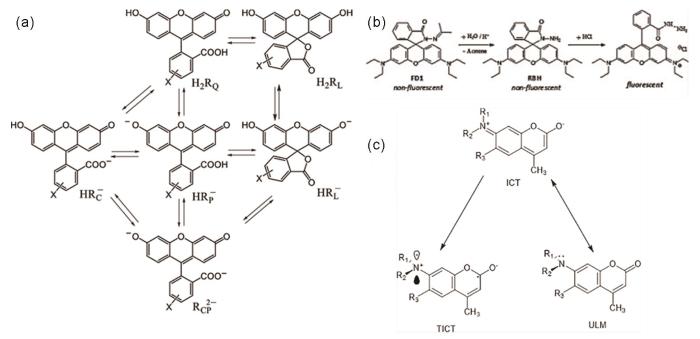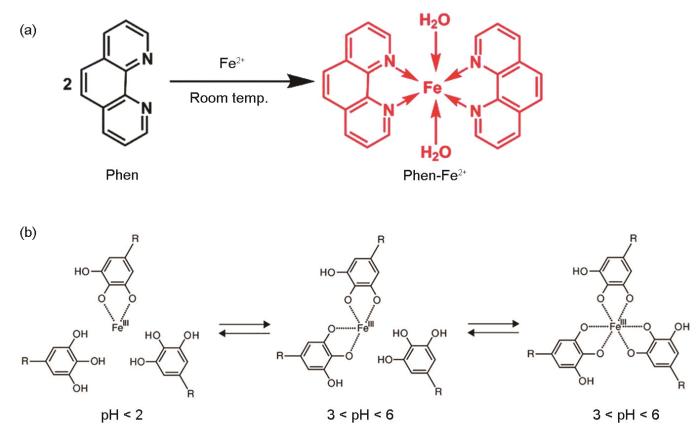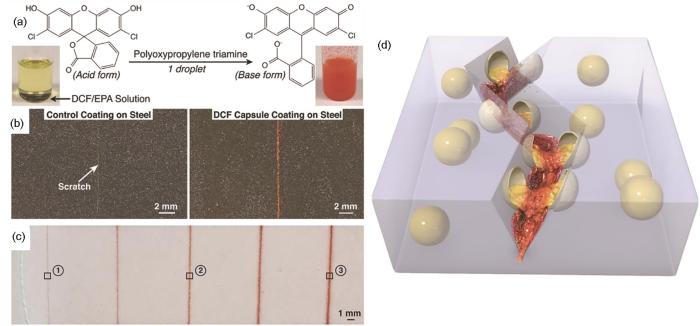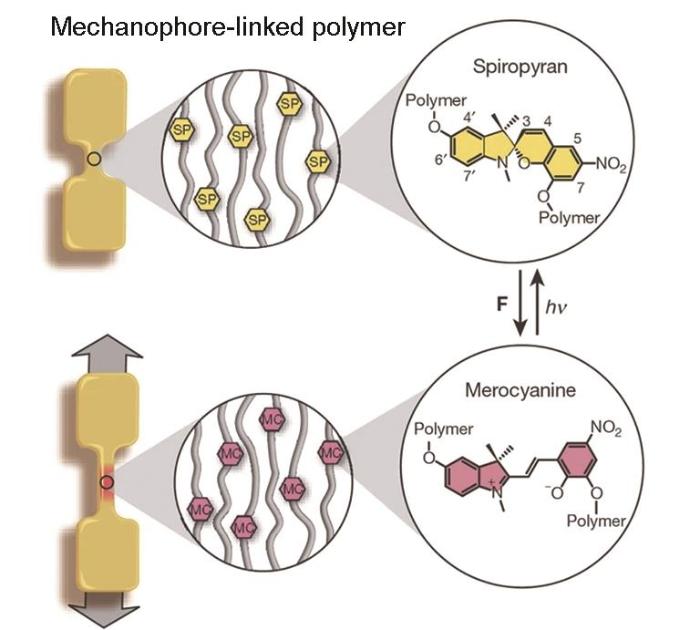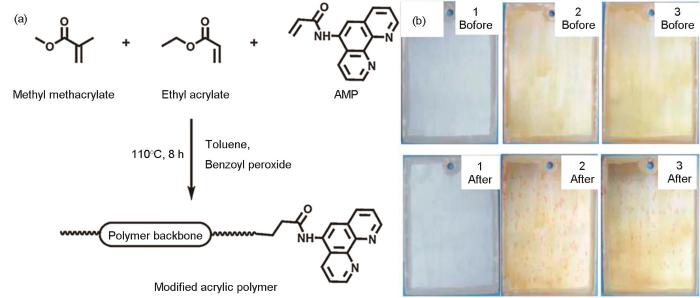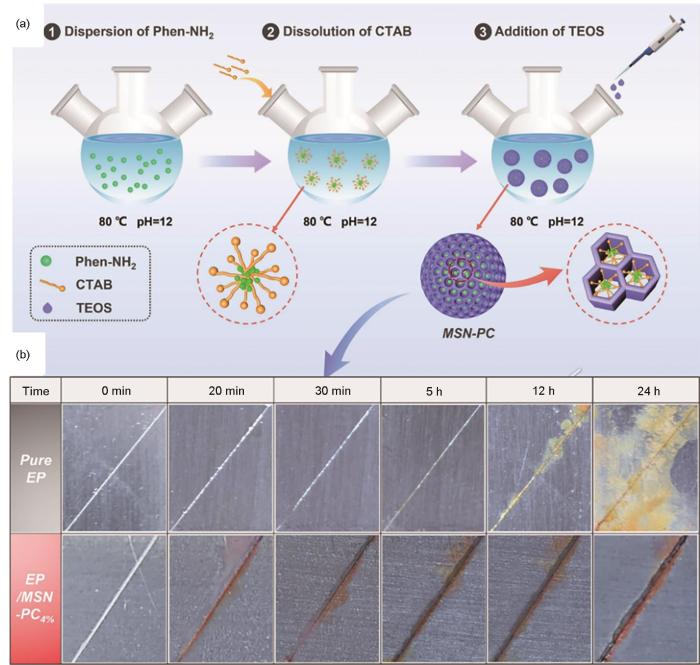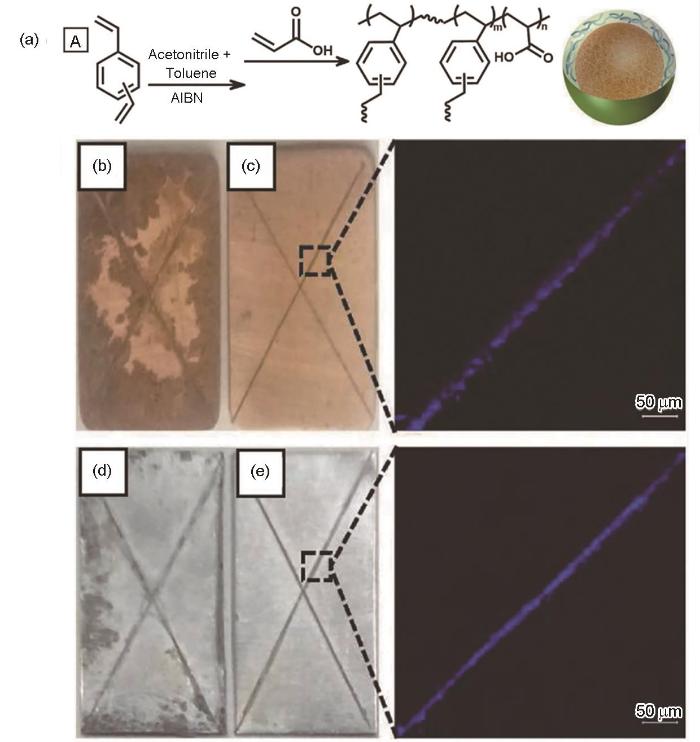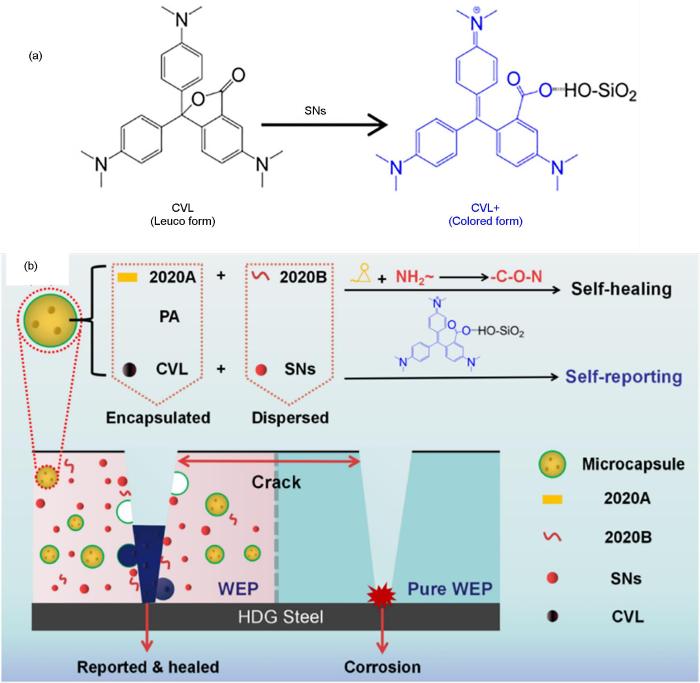目前对涂层缺陷的检测多采用物理方法,如电化学方法[7],声发射技术[8],热成像技术等[9],但所需的测试设备昂贵,且不易携带至现场检测。近年来,自预警涂层受到研究人员的关注,当出现老化缺陷时,涂层会发出预警信号,以提醒维保人员及时进行维护更换。金属腐蚀伴随着阳极氧化、水解酸化两个平行反应,腐蚀位点处产生H+、OH-以及金属离子[10~12]。基于腐蚀原理,在涂层中掺杂H+、OH-、金属离子的荧光/颜色响应物质,可制备缺陷自预警涂层。在宏观腐蚀产物出现前,通过涂层的荧光/颜色变化,确定金属基体微区腐蚀活性位点。对于机械损伤造成的涂层失效,可通过修饰力致变色基团[13]或添加荧光/染料微胶囊,纳米纤维[14]等来指示涂层的老化程度。此外,自预警和自修复协同作用可提高涂层的可靠性,延长涂层的服役寿命,降低人工维修成本[15],因此开发自预警/自修复双功能涂层也是研究热点之一。
本文先总结了自预警涂层的荧光/颜色响应触发机制,并介绍了适配不同类型自预警涂层的应用场景。接着对自预警涂层的制备策略进行分类,并简要评述了不同制备策略的优势与局限性,重点阐明纳米负载容器在自预警涂层中起到的关键作用。此外,还介绍了近年受到关注的自修复自预警双功能涂层。最后对目前开发自预警涂层所面临的挑战和未来的研究方向进行展望,以期助力智能自预警涂层的研究及其应用。
1 基于不同触发机制的自预警涂层
自预警涂层的触发机制可分为两类,一类是腐蚀触发型,即金属基体腐蚀产生的pH变化或是离子释放,刺激涂层发出预警信号;另一类则是机械触发型,当涂层受到机械损伤后,缺陷指示剂释放实现涂层的自预警。
1.1 腐蚀触发型
1.1.1 pH响应
当涂层老化降解后,金属基体的阳极区域发生水解酸化,阴极区域消耗O2,产生OH-[10~12],在涂层中添加pH响应的颜色指示剂、荧光探针,可实现膜下金属的早期腐蚀预警。
酚酞作为pH指示剂,常被用于涂层腐蚀传感器。相比于pH 1.6~8.7由红变黄再变蓝色的百里酚蓝[16],pH 7.2~8.8由黄变红再变紫的甲酚红,pH 3.8~5.4由黄变绿再变蓝的溴甲酚蓝,酚酞在pH为8.2时会由无色变为粉红色,显色对比度高,更容易定位局部金属腐蚀位点。无色内酯式酚酞含两个酚羟基与一个酯基,当内酯水解的羧基与酚羟基酸性被中和后,酚氧负离子反馈给苯环电子,促使连接三苯环的中心碳原子脱醇羟基发生sp3杂化,两苯环大π键通过中心碳原子与苯醌形成超大共轭体系的红色醌式酚酞[17](图1),宏观上表现为酚酞遇碱变红。此外,甲酚红、溴甲酚蓝[18]、百里酚蓝[19]同样受pH影响,其内部的磺酸内酯开环,形成大型共轭结构而变色,也可被应用于自预警涂层。Zhang和Frankel[20]将酚酞指示剂直接分散在丙烯酸涂层,可指示碱性的阴极区腐蚀。Sousa等[18]将壳聚糖(ChiMSs)作为载体,分别包裹酚酞(PhPh)、甲酚红、溴甲酚蓝,制备AA2024铝合金预警涂层。壳聚糖包覆的甲酚红、溴甲酚蓝浸泡在中性3.5%(质量分数)NaCl溶液均可有效预警,PhPh@ChiMSs掺杂的涂层则需浸泡在pH为12的溶液中才能发生显色反应,而一般的腐蚀环境难以达到如此高的碱性,这也限制了PhPh作为腐蚀传感器的应用场景。
图1
在涂层中添加颜色指示剂可在白天肉眼观察颜色变化,然而,颜色传感器的显色效果却受到涂层与腐蚀产物自身颜色的干扰[21]。对比之下,荧光活性物质在紫外光激发下的显色反应,抗干扰能力强,且指示灵敏度高、检测限低[22, 23]。最简单的荧光预警涂层是将荧光素与树脂共混,内酯结构的荧光素在碱性条件下水解,强还原性的酚氧负离子,促使中心碳原子sp2杂化,两个苯环与一个苯醌通过C-C双键形成强共轭刚性平面并对外发出荧光(图2a)[24]。然而,荧光素能与涂层中的胺基固化剂反应,在金属基体腐蚀发生前开环,造成荧光误报警[25]。荧光剂FD1为内酰胺结构,与荧光素的荧光机理类似,FD1在酸性条件下水解成具有荧光活性的罗丹明酰肼,且不受氨基固化剂的干扰(图2b)。Augustyniak和Ming[26]将FD1直接添加到环氧涂层中,在紫外光照下铝合金基板腐蚀位点发出亮橙色荧光。对于本征荧光涂层,其本身会吸收部分的荧光,随着涂层厚度的增加,将削弱荧光预警效果。Liu和Wheat[27]在环氧涂层中添加荧光分子7-氨基-4-甲基香豆素(香豆素120),在紫外光刺激下,电子从氨基分子内转移到香豆素羰基,激发态偶极矩发生较大改变,Stokes位移增大,出现荧光现象(图2c)。一旦腐蚀阳极产生H+中和氨基的给电子能力,该腐蚀区域的荧光淬灭。但涂层过厚会削弱荧光淬灭观察效果,最佳的涂层厚度应控制在80 μm以内。
图2
1.1.2 金属离子响应
金属腐蚀反应除生成H+,还产生游离的金属离子。金属离子空轨道易与含N、O、S的低共轭化合物形成配位键,针对不同金属离子形成多种类型的螯合环,显示出颜色/荧光变化。受应力影响,五元螯合环倾向于选择半径较大的金属离子,六元螯合环倾向于选择半径较小的金属离子,表现出良好的选择性[29]。
菲啰啉是面刚性共轭结构,两个非极性N配位原子提供π电子,与Fe2+的3d轨道形成配位键,形成醒目的红色五元环螯合网络(图3),使得菲啰啉及其衍生物成为公认有效的Fe2+指示剂。Li等[30]用1,10-菲啰啉-5胺修饰的氧化石墨烯作为腐蚀传感器监测聚氨酯涂层对碳钢的防护能力。单宁酸也可作为Fe3+指示剂用于制备自预警涂层。单宁酸是一个以葡萄糖单元为中心,四周环绕10个没食子酸单元的低聚酯分子,随腐蚀阴极区域pH不断增加,没食子酸单元中两个相邻的羟基脱氢,以氧负离子形式与Fe3+络合产生颜色变化[31]。Ejima等[32]认为当环境pH > 7时,单宁酸分子中的3个没食子酸单元与Fe3+形成稳定的八面体络合物,吸收可见光显色(图3)。Liu等[33]以聚乙二醇-单宁酸为壳,包裹苯并咪唑的ZIF-7为核制备了双功能纳米传感器,将其作为填料制备自预警涂层。金属基体腐蚀产生的Fe3+与单宁酸结合,形成蓝黑色螯合物,指示基体的早期腐蚀和涂层失效位点。
图3
目前离子显色剂主要用于Fe基腐蚀自预警涂层,而对于Al、Mg、Cu基板腐蚀触发的显色剂在涂层中的应用尚未报道,这也限制了显色自预警涂层的发展。相比之下,不同类型的金属离子荧光探针可用来制备智能预警涂层。螯合增强荧光效应(CHEF)相比于螯合增强淬灭(CHEQ)更易于观察,这也是大多数金属离子荧光探针的发光机制。荧光探针中含有一对能量高于荧光团主体HOMO轨道能量的孤对电子,当荧光团HOMO的一个电子被激发时,孤对电子通过光诱导电子效应转移到荧光团基态。当孤对电子与金属离子形成配位键时,轨道能量低至荧光团基态以下,探针的荧光增强。受金属离子的顺磁性、体积大小、自选耦合常数与螯合环应变力影响,不同的荧光探针能选择性地识别金属阳离子[29]。例如罗丹明B-乙二胺添至环氧涂层中监测铜质文物腐蚀,Cu2+促进其内酰胺开环,开环后的罗丹明B-乙二胺与Cu2+络合,形成亮红色荧光七元螯合环[35]。FD1内酰胺开环后可与Fe3+五元螯合,开启亮黄色荧光,以制备碳钢智能预警涂层[22]。Al3+引起的苯基荧光酮荧光淬灭的反应也被应用到Al基自预警涂层[36]。
由上可知,腐蚀触发型自预警涂层的响应机制可细分为pH响应和金属离子响应,两者在应用上各有优势但也存在不足。如酚酞pH响应显色可用于制备铝合金、碳钢、镁合金基体[37]的腐蚀自预警涂层,对于强碱性腐蚀产物的镁合金而言,酚酞腐蚀显色的效果最好。而对于碳钢、铜合金等基体,其腐蚀产物的碱性较弱,酚酞显色预警的报错率明显增加[38]。金属离子触发型自预警涂层可利用荧光探针检测微量腐蚀性离子,准确定位涂层缺陷位点,但此类涂层设计复杂,制备成本高,难以大规模应用。因此,需要根据自预警涂层的性能特点适配应用场景,如镁合金基透明涂层中掺杂具有缓蚀性的pH指示剂酚酞[39],碳钢基自预警涂层可添加既是颜色指示剂又是缓蚀剂的菲啰啉衍生物[40],铝合金基则可利用8-羟基喹啉的荧光指示和缓蚀的双功能性制备自预警涂层[41]。
1.2 机械触发型
与腐蚀触发型自预警涂层不同,机械触发型涂层是对其微裂纹进行指示预警。当涂层受到机械损伤时,内部的微胶囊释放显色剂或荧光物质,以定位涂层的裂纹缺陷[34, 42],或者直接将力致变色分子引入到高分子网络结构中,制备应力敏感涂层。对于前者,部分颜色指示剂和荧光探针可与涂层氨基固化剂反应,例如2′, 7′-二氯荧光素(DCF)与氨基反应从浅黄色变为鲜红色。Li等[43]将DCF封装到聚氨酯/聚脲甲醛(PU/UF)双壳壁微胶囊中再分散至环氧涂层(图4),当涂层出现机械损伤时,微胶囊破损,DCF流出与胺类固化剂结合成红色物质,颜色强度随划痕深度与DCF微胶囊浓度增加而增强。此外,结晶紫(CVL)可以与含羟基的氧化物如SiO2,Al2O3,CaO等通过氢键结合,快速从无色内酯环转化为大共轭结构的蓝色三苯基甲烷(CVL+)[44],CVL被封装在聚甲基丙烯酸甲酯(PMMA)壳中,胶囊外修饰SiO2纳米粒子,当涂层产生裂缝时,流出的CVL与胶囊壁上SiO2结合发生蓝色预警信号[44]。对于后者,可选用应力敏感性螺吡喃制备自预警涂层,螺碳-氧键受力断裂,无色的螺吡喃转变为红色碳-碳双键连接的大型共轭平面结构,将螺吡喃基团接枝到聚丙烯酸酯上,涂层受力损伤时会发出红色预警(图5)[45]。
图4
图4
DCF颜色变化原理,空白环氧涂层与含10%DCF胶囊涂层划痕预警对比,含15%DCF胶囊涂层对不同划痕深度的预警和机械损伤颜色变化示意图[43]
Fig.4
DCF color change mechanism (a), comparison of scratches reporting between blank epoxy coating and epoxy coating with 10% DCF microcapsules (b), early reporting of 15% DCF microcapsule coating for varying scratches depth (c) and schematic diagram of color change due to mechanical damage (d)[43]
图5
聚集诱导发光(AIE)现象于2001年被LAM等观察到[46],发光源AIEgens结构是C-C或N-N单键连接多个共轭体系,稀释状态下分子自由转动,不激发荧光信号。当AIEgens聚集,分子内运动受到限制,较大的Stokes位移让吸收的光子信号以辐射方式发出荧光[47, 48]。近年来已有AIE型自预警涂层的报道,涂层破损释放AIEgens,待微裂纹处溶剂挥发后可显示出强烈荧光。例如Lu等[49]将发红色荧光的富马腈(BPF),绿色荧光的六苯基硅烷(HPS)与蓝色荧光的1, 1, 2, 2-四苯乙烯 (TPE) 这3种聚集诱导发光源,分层制备荧光显色层,并通过荧光颜色的变化预警涂层损伤深度。由机械触发型自预警涂层的特性可知,涂层设计时需要综合考虑受力破坏的响应敏感性以及自身的刚性,既要在微作用力下避免指示物质的过早泄露,又要及时触发强破坏损伤下的缺陷指示。
2 自预警涂层的制备策略
自预警涂层的制备大体可以分为两种策略:一种是将指示基团接枝到聚合物网络中,合成本征自预警涂层;另一种则是将指示物质封装到纳米容器中,作为功能填料与涂层复合,通过颜色/荧光变化指示涂层老化位点。
2.1 接枝指示基团
在涂层中接枝含氨基或者羟基的菲啰啉衍生物实现自预警功能,例如Dhole等[50, 51]用1, 10-菲啰啉-5-胺修饰醇酸树脂和环氧树脂,并用菲啰啉制备改性丙烯酸涂料(图6)。通过谱学分析证明改性树脂中含有菲啰啉结构,可与基体腐蚀释放的Fe2+形成红色络合物,以此来指示涂层缺陷,非极性菲啰啉基团修饰涂层后,提高了涂层的疏水防护性能。相比显色反应,荧光探针指示的检测限低、灵敏度更高。将罗丹明衍生物丙酰胺开启荧光接枝到环氧树脂中,在Fe2+和H+刺激下碳钢腐蚀区域会出现橙色荧光斑点[52]。Yuan等[53]将强π-π堆积聚集荧光淬灭的1, 5-二羟基萘(1, 5-DN)分子键合到聚氨酯主链,通过聚合物分子链的物理纠缠和相互作用限制其堆积,制备具有pH响应的本征荧光涂层。He等[54]将异硫氰酸荧光素(FITC)作为小分子单体,嵌入水性聚氨酯主链制备嵌段共聚物(FWPU),结果表明FITC在FWPU中均匀分散,FWPU薄膜和溶液都呈现出清晰的黄绿色荧光。FWPU涂层与FITC溶液相比,受对苯二甲酚淬灭剂影响小。
图6
2.2 纳米容器负载指示物质
早期制备智能预警涂层是将荧光素直接掺入涂层,但指示剂与氨基固化剂的不良相互作用会导致荧光过早指示[56],涂层的物理屏蔽性能与粘附强度也被削弱[57, 58]。为此,可利用介孔SiO2[59]和层状LDH[60],聚合物微胶囊[61]等容器封装腐蚀传感基团,避免活性物质与涂层树脂直接接触。在外界刺激下,纳米容器释放活性物质,指示涂层损伤与金属基体的早期腐蚀。Fan等[62]用锆金属有机骨架(Zr-MOF@RhB)包覆罗丹明B(Zr-MOF@RhB)制备复合涂层来区分涂层微裂纹和基底Al的腐蚀,涂层表面出现裂纹时显橙黄色荧光,当损伤深至基底引起Al腐蚀时,荧光变为绿色。此外,纳米容器还能提高腐蚀检测的灵敏度,如Wang等[63]将罗丹明B衍生物(RHS)与Cu2+结合成玫瑰红色络合物,并开启荧光的颜色/荧光双响应指示剂—RHS封装到ZIF-8后,涂层预警所需的最低RHS添加量为0.14%(质量分数),而未使用ZIF-8时,添加量需达到0.5%。Raps等[57]研究表明直接添加到涂层中的缓蚀剂会与涂层中某些成分相互作用,进而劣化涂层防护性能。基于此,Galvão等[64]制备两组涂层进行对比:一组将包覆酚酞的介孔SiO2作为腐蚀传感器填充在涂层中,另一组直接共混酚酞。实验证明介孔SiO2负载能提高腐蚀指示剂与涂层基体的相容性[65],只有当腐蚀产生的OH-扩散至介孔SiO2中才会显色预警,而酚酞共混涂层出现腐蚀误报警[66]。然而,使用介孔SiO2制备的腐蚀传感器还存在一些问题,首先是纳米传感器在有机涂层内的分散性较差,Liu等[34]将1, 10-菲啰啉封装到介孔SiO2后再包覆一层壳聚糖(MSN-Phen@CS),腐蚀传感器在涂层中的分散性增强,且不易产生明显的缺陷。尽管有报道称壳聚糖存在快速释放活性物质的不足,但其含有的氨基和羟基可作为功能基团的修饰位点[18]。其次,介孔SiO2中腐蚀指示物质的负载量较低,难以对离传感器较远的涂层损伤进行有效预警[67],因此需要设计高负载量的新型纳米容器。Liu等[68]分别用壳聚糖/藻酸盐和ZIF-8封装CaCO3微容器,两者对1, 10-菲啰啉-5-胺的负载量高达20.1% 和19.4 %,且微容器能pH响应释放菲啰啉,对腐蚀缺陷的预警能力显著提高。此外,介孔材料还存在过早泄漏显色剂的问题,Wang等[69]将1, 10-菲啰啉-5-胺(pHen-NH2),与既是模板剂又为缓蚀剂的十六烷基三甲基溴化铵(CTAB)结合,一同封装入介孔SiO2(MSN-PC),介孔SiO2和模板的双重作用防止显色剂过早反应(图7)。
图7
表1 部分自预警涂层颜色指示剂及其变化应用
Table 1
| Reacting species | Color indicator | Container | Substrate | Change | Coating | |
|---|---|---|---|---|---|---|
| Mechanically | - | DCF + amine | PU/UF | Steel | Red | Epoxy[43] |
| triggered | - | CVL + SiO2 | PMMA | Steel | Blue | WEP[71] |
| - | BPF/HPS/TPE | PU/UF | Glass | Colors are related to crack depth | Epoxy[49] | |
| Fluorescence | H+ | FD1 | - | Al alloy | Bright orange | Epoxy[26] |
| response | H+ | Coumarin 120 | - | Al alloy | CHEQ | Epoxy[27] |
| OH- | Coumarin | PDVB- grafting- P (DVB- co-AA) | Steel | CHEF | Epoxy[72] | |
| Fe3+ | FD1 | - | Steel | Bright yellow | Epoxy[22] | |
| Fe3+ | Rhodamine B derivative | Silica nanocapsules | Steel | Bright yellow | Poly(vinyl butyral-co-vinyl alcohol-co-vinyl acetate)[66] | |
| Fe3+ | 8-HQ | PAN1 | Steel | CHEF | Epoxy[73] | |
| Al3+ | 8-HQ-5-sulfonic acid | - | Al alloy | CHEF | Epoxy[56] | |
| Al3+ | Phenylfluorone | - | Al alloy | CHEQ | Acrylic coating[36] | |
| Al3+ | Rhodamine B | Zr-MOF | Al alloy | Green | Epoxy[62] | |
| Cu2+ | Rhodamine-ethylenediamine | - | Cu alloy | Bright red | Epoxy[35] | |
| Cu2+ | RHS | ZIF-8 | Cu alloy | Rose red/ CHEF | Epoxy[63] | |
| Color | OH- | Phenolphthalein | Silica nanocapsules | Al alloy | Pink | Water-soluble acrylic urethane[64] |
| response | ||||||
| OH- | Phenolphthalein | P (MMA-co-BA) | Steel | Pink | Acrylic coating[74] | |
| Fe2+ | 1,10-phenanthroline | Silica nanocapsules/Chitosan | Steel | Red | Waterborne Epoxy[34] | |
| Fe2+ | 1,10-phenanthroline-5-amine | Graphene oxide | Steel | Red | Polyurethane[30] | |
3 自预警自修复双功能涂层
自预警自修复双功能涂层的常见制备方法,是将腐蚀指示剂和修复剂分别封装在两个单独容器中,如Wang等[72]合成了具有pH响应性的纳米胶囊—聚(二乙烯基苯)-接枝-聚(二乙烯基苯-共-甲基丙烯酸)(PDVB-graft-P(DVB-co-AA)),分别负载15%苯并三唑缓蚀剂和荧光剂香豆素。腐蚀引起pH升高时,PDVB-graft-P(DVB-co-AA)去质子化,静电排斥和吸水膨胀导致聚合物空隙增大,胶囊中的缓蚀剂和香豆素得以持续释放,在实现荧光预警的同时可抑制金属腐蚀(图8)。然而上述方法制备工艺繁琐,可以将两者集成在同一纳米容器中起到一石二鸟的效果。如Salaluk等[74]将酚酞(PNL)和缓蚀剂2-巯基苯并噻唑(MBT)通过静电纺丝的手段,封存在聚乙烯醇缩甲醛纳米纤维中形成复杂网络,其在负载量和指示剂运输速率上比离散随机分布的纳米胶囊更胜一筹。该复合涂层能够及早发现涂层损坏,并且对破损涂层有一定的修复抑制作用(图9)。
图8
图9
本征自愈合涂层与外源型缓蚀剂协同作用,可修复更大尺寸的涂层缺陷,Liu等[82]在聚氨酯涂层中掺杂负载苯并咪唑和1, 10-菲啰啉的氧化石墨烯-沸石咪唑骨架(图10),金属基体腐蚀时,局部酸性环境刺激纳米容器分解,释放的菲啰啉发出红色预警。在近红外光照下,具有光热效应的氧化石墨烯促进聚氨酯自愈合,Phen和苯并咪唑作为缓蚀剂有效抑制腐蚀发生,腐蚀区域颜色逐渐变淡,缺陷周围颜色的变化可追踪基体腐蚀发展与损伤修复过程。Tao等[71]以CVL为显色剂,环氧树脂单体为愈合剂,与酸性溶液乙酸苯酯(PA)一同封装到聚甲基丙烯酸甲酯(PMMA)微球,再将其与纳米SiO2(SNs)和环氧树脂固化剂分散在水性环氧涂料中(图10)。涂层受到机械损伤时,PMMA释放CVL与含羟基的SiO2反应,内酯开环后中心C原子重新杂化形成蓝色共轭结构,同时释放愈合剂修复涂层裂纹缺陷。
图10
4 结论与展望
本文综述了近几年自预警涂层的研究进展,总结了pH及金属离子触发型自预警涂层的颜色/荧光机制,以及机械触发型自预警涂层。针对两种自预警涂层的制备策略,重点强调纳米容器封装对实现自预警的重要性,并回顾了自预警自修复双功能涂层的发展趋势。并对自预警涂层研发中急需解决的问题做了一些展望:
(1) 优化制备工艺:纳米容器负载指示物型自预警涂层,制备工艺简单,但也面临与涂层本体相容性差,不利于腐蚀传感器均匀分散,无法对损伤有效预警;聚合物微胶囊的机械强度不足易造成指示物质泄漏,引起误报。尽管接枝型自预警涂层能提高指示物质的分散性,但指示物与涂料本体键合需要具备特定基团,制备过程复杂,不利于大规模生产。未来自预警涂层的制备需统筹考虑两种制备策略的优势,以提高指示剂在涂层中的分散性及稳定性,简化制备工艺,降低生产成本。
(2) 完善自预警性能:目前,大多数自预警涂层只具备单一监测金属腐蚀或指示涂层机械损伤的功能,开发兼顾腐蚀触发与机械触发自预警涂层,区分涂层早期破损与金属基体腐蚀,仍需进一步深入研究。此外,通过颜色/荧光变化追踪涂层损伤动力学过程,或通过显色面积指示金属腐蚀程度,也是未来自预警涂层的重要研究方向之一。
(3) 改进多功能涂层配伍性:对于自预警自修复双功能涂层而言,需要探索开发更多缓蚀剂/愈合剂与预警指示剂组合配方,但这些功能添加剂之间存在配伍性问题。需要设计有针对性的多种纳米容器实现独立包覆,提高多种指示剂填料之间的配伍性及其在树脂中的分散性。
(4) 研究自预警机制:目前的研究在解释荧光/颜色变化机制方面有所欠缺,可结合量子化学理论计算分析光子吸收、发射、电子跃迁机理,为荧光探针与颜色指示剂的荧光/颜色行为提供理论基础。
参考文献
Rational assembly of mussel-inspired polydopamine (PDA)-Zn (II) complex nanospheres on graphene oxide framework tailored for robust self-healing anti-corrosion coatings application
[J].
Progress of sol-gel anti-corrosion coatings on metals
[J].
金属表面溶胶-凝胶防腐蚀涂层的研究进展
[J].
Synergistic reinforcement coating with anti-corrosion and UV aging resistance by filling modified CeO2 nanoflakes
[J].
Preparation of dual-chamber microcapsule by Pickering emulsion for self-healing application with ultra-high healing efficiency
[J].
Amino-functionalized MXene nanosheets doped with Ce(III) as potent nanocontainers toward self-healing epoxy nanocomposite coating for corrosion protection of mild steel
[J].
Accelerated aging of anticorrosive coatings: Two-stage approach to the AC/DC/AC electrochemical method
[J].
Progress in corrosion inhibitor evaluation and corrosion monitoring technology in oil recovery industries
[J].
油气工业缓蚀剂评价与腐蚀监测技术进展
[J].
Review of on-line monitoring of oil and gas pipelines corrosion in acidic environment by acoustic emission technology
[J].
声发射在线监测酸性环境下油气管材腐蚀研究综述
[J].
Automated detection and quantification of the onset of undercoating corrosion using pulsed thermography
[J].
Analysis of corrosion processes kinetics on the surface of metals
[J].
Detection of corrosion inhibitor adsorption via a surface-enhanced Raman spectroscopy (SERS) silver nanorods tape sensor
[J].
Superhydrophobic surfaces for corrosion protection: a review of recent progresses and future directions
[J].
Mechanical force sensitive acrylic latex coating
[J].
Synthesis of smart nanofiber coatings with autonomous self-warning and self-healing functions
[J].
Mechanochromic and thermally reprocessable thermosets for autonomic damage reporting and self-healing coatings
[J].Autonomous polymers that report damage prior to loss of function and simultaneously self-heal are highly relevant for preventing catastrophic failures and extending the lifetimes of materials. Here, we demonstrate mechanochromic and thermally reprocessable thermosets that can be used for autonomic damage reporting and self-healing coatings. A mechanochromic molecule, spiropyran (SP), is covalently incorporated into thermoreversible Diels–Alder (DA) cross-linking networks. Mechanical activation of SPs in DA networks is confirmed by computational simulations and mechanical testing. The damaged areas of the polymers change colour, emit fluorescence signals, and completely recover after heat treatment. Because of the thermoreversible covalent networks, these polymers can be recycled up to fifteen times without degrading their mechanical, damage-reporting, or self-healing properties. Our autonomic material systems provide a new way to enhance the lifespans and reliabilities of thermosetting coatings, which also expands the range for practical applications of force-induced chemical reactions in polymers.
Finding the pKa values of a double-range indicator thymol blue in a remote learning activity
[J].
Several common mechanisms of color change reaction of phenolphthalein indicator
[J].
酚酞指示剂变色反应的几种常见机理
[J].
Chitosan microspheres as carriers for pH-indicating species in corrosion sensing
[J].
Dual stimuli responsive self-reporting material for chemical reservoir coating
[J].
Corrosion-sensing behavior of an acrylic-based coating system
[J].
Active sensing coating for early detection of corrosion processes
[J].
Early detection of steel corrosion via “Turn-On” fluorescence in smart epoxy coatings
[J].
Research progress on design, preparation and application of fluorescent coatings
[J].
荧光涂层的设计、制备与应用研究进展
[J].
Aminofluoresceins versus fluorescein: peculiarity of fluorescence
[J].
A selective optical chemical sensor for o-nitrophenol based on fluorescence quenching of curcumin
[J].An optical chemical sensor has been prepared for the selective determination of o-nitrophenol in aqueous solutions based on the fluorescence quenching of curcumin in PVC membrane. The sensing mechanism of the proposed sensor for o-nitrophenol has been discussed in detail. The fluorescence changes of sensing membrane resulted from an associated complex formation between curcumin and o-nitrophenol. In pH 4.8 buffer solution, the sensor responds linearly in the measuring range from 1.0 x 10(-2) mol 1(-1) to 1.5 x 10(-4) mol 1(-1), and the experimental detection limit is evaluated to be 8.0 x 10(-5) mol 1(-1). A stable signal was obtained within less than 1.5 min. Under the optimum conditions, the sequence of selective response to the sensing membrane is o-nitrophenol > 2,4-dinitrophenol > m-nitrophenol > p-nitrophenol > 2,4,6-trinitrophenol. Phenol, aniline as well as other ions have less effect on the fluorescence of the sensor. The reproducibility for the determination of o-nitrophenol is better than 1%, and the response is reversible. The sensor can be used for the determination of o-nitrophenol in water samples.
Early detection of aluminum corrosion via “turn-on” fluorescence in smart coatings
[J].
Use of a fluorescent indicator in monitoring underlying corrosion on coated aluminum 2024-T4
[J].
Photophysical features of coumarin 120 in reverse micelles
[J].
The pyridyl group in ligand design for selective metal ion complexation and sensing
[J].Factors in polypyridyl ligands that control their thermodynamic metal ion selectivity in aqueous solution, and their use in selective fluorescent sensing, are examined. Preorganization of polypyridyl ligands ranging from bidentate to tetradentate by bridging benzo groups, as are present in 1,10-phenanthroline (phen) compared to 2,2'-bipyridyl (bpy), is discussed. The role of solvation is considered in relation to the relative affinity of ligands containing pyridyl groups for divalent and trivalent metal ions in aqueous solution. The effects of steric clashes between H atoms on polypyridyl ligands in decreasing complex stability are evaluated, as well as the effect of chelate ring size on metal ion selectivity. Phen ligands with other donor groups present at the 2 and 9 positions, such as alcohols, amides, carboxylates, and oximes are discussed. The design of pyridyl-based ligands for the separation of Am(III) from lanthanide(III) ions is considered, as well as ligands for the removal of metal ions such as Cu(II) or Zn(II) in neurological diseases such as Alzheimer's. The design of pyridyl-based fluorescent sensors for selective sensing of metal ions is examined in terms of the role of spin-orbit coupling constants (ζ), paramagnetism, and steric effects in the development of selective fluorescent sensors that operate via chelation enhanced fluorescence (CHEF). It is concluded that for lighter metal ions with smaller ζ values such as Zn(II) and Ca(II), and to a lesser extent Cd(II), that the CHEF effect can be achieved with pyridyl-containing fluorophores that coordinate directly to the metal ion. The way in which steric effects can be used to decrease the CHEF effect in Zn(II) relative to Cd(II) to enable selective sensing of the latter is analyzed. For heavier metal ions such as Hg(II) and Pb(II), because of their large ζ values which quench fluorescence, it is concluded that the fluorophore should be tethered to the metal-binding part of the sensor, and prevented from binding to the metal ion by steric and electronic factors. How Hg(II) can quench the CHEF effect by π-contact with fluorophores such as the anthracenyl group, which at first sight might not seem able to bond with metal ions, is examined.
Functionalized graphene/polymer composite coatings for autonomous early-warning of steel corrosion
[J].
Applications of tannic acid in membrane technologies: A review
[J].
One-step assembly of coordination complexes for versatile film and particle engineering
[J].The development of facile and versatile strategies for thin-film and particle engineering is of immense scientific interest. However, few methods can conformally coat substrates of different composition, size, shape, and structure. We report the one-step coating of various interfaces using coordination complexes of natural polyphenols and Fe(III) ions. Film formation is initiated by the adsorption of the polyphenol and directed by pH-dependent, multivalent coordination bonding. Aqueous deposition is performed on a range of planar as well as inorganic, organic, and biological particle templates, demonstrating an extremely rapid technique for producing structurally diverse, thin films and capsules that can disassemble. The ease, low cost, and scalability of the assembly process, combined with pH responsiveness and negligible cytotoxicity, makes these films potential candidates for biomedical and environmental applications.
Stimulus responsive zeolitic imidazolate framework to achieve corrosion sensing and active protecting in polymeric coatings
[J].
Synthesis of nanosensors for autonomous warning of damage and self-repairing in polymeric coatings
[J].Polymeric materials are susceptible to minor damage, which is undetectable. Without timely and effective repair treatment, the damage may deteriorate the integrity of the materials and ultimately result in material failure and catastrophe. Autonomous warning and simultaneous damage repair are of great practical significance yet difficult to realize. Herein, we introduce a smart coating with autonomous warning and repairing of damage by the simple incorporation of nanosensors embedded with phenanthroline as a corrosion indicator and inhibitor. The electrochemical corrosion resulting from coating damage can be rapidly indicated by a prominent orange-red color in just five minutes. In addition to the warning function, the smart coating exhibits efficient self-repairing in the defective region, as reflected from the disappearance of the electrochemical admittance peak. This simple and powerful strategy dependent on a single active component to achieve an autonomous warning and repairing effect is highly expected to provide a new avenue for enhancing the security and longevity of other polymeric materials.
Corrosion monitoring effect of rhodamine-ethylenediamine on copper relics under a protective coating
[J].
Preparation and performance of fluorescent sensing coating for monitoring corrosion of Al alloy 2024
[J].
Nanocontainer-based corrosion sensing coating
[J].
Validating the early corrosion sensing functionality in poly (ether imide) coatings for enhanced protection of magnesium alloy AZ31
[J].
Synthesis and characterization of phenolphthalein derivatives, detailed theoretical DFT computation/molecular simulation, and prevention of AA2024-T3 corrosion in medium 3.5% NaCl
[J].
Corrosion-sensing and self-healing dual-function coating based on 1,10-phenanthroline loaded urea formaldehyde microcapsules for carbon steel protection
[J].
8-hydroxyquinoline-modified clay incorporated in an epoxy coating for the corrosion protection of carbon steel
[J].
Eco-friendly synthesis of self-reporting robust superhydrophobic coatings with damage sensitive photoluminescence
[J].
Autonomous indication of mechanical damage in polymeric coatings
[J].
Solvatochromic coatings with self-cleaning property from palygorskite@polysiloxane/crystal violet lactone
[J].
Force-induced activation of covalent bonds in mechanoresponsive polymeric materials
[J].
Linear and hyperbranched polymers with high thermal stability and luminescence efficiency
[J].
Aggregation-induced emission for visualization in materials science
[J].
Specific light-up bioprobes based on AIEgen conjugates
[J].Driven by the high demand for sensitive and specific tools for optical sensing and imaging, bioprobes with various working mechanisms and advanced functionalities are flourishing at an incredible speed. Conventional fluorescent probes suffer from the notorious effect of aggregation-caused quenching that imposes limitation on their labelling efficiency or concentration to achieve desired sensitivity. The recently emerged fluorogens with an aggregation-induced emission (AIE) feature offer a timely remedy to tackle the challenge. Utilizing the unique properties of AIE fluorogens (AIEgens), specific light-up probes have been constructed through functionalization with recognition elements, showing advantages such as low background interference, a high signal to noise ratio and superior photostability with activatable therapeutic effects. In this tutorial review, we summarize the recent progress in the development of specific AIEgen-based light-up bioprobes. Through illustration of their operation mechanisms and application examples, we hope to provide guidelines for the design of more advanced AIE sensing and imaging platforms with high selectivity, great sensitivity and wide adaptability to a broad range of biomedical applications.
Autonomous damage detection in multilayered coatings via integrated aggregation-induced emission luminogens
[J].
Smart corrosion sensing phenanthroline modified alkyd coatings
[J].
Modified epoxy coatings for corrosion detection
[J].
Fluorescence based corrosion detecting epoxy coating
[J].
A multifunctional polyurethane with solid-state and acid-base responsive fluorescent emission
[J].
Enhanced fluorescence properties of flexible waterborne polyurethane films by blocking fluorescein isothiocyanate (FITC)
[J].
Smart acrylic coatings for corrosion detection
[J].
The use of fluorescent probes for the detection of under-film corrosion
[J].
Electrochemical study of inhibitor-containing organic-inorganic hybrid coatings on AA2024
[J].
Monitoring underlying epoxy-coated St-37 corrosion via 8-hydroxyquinoline as a fluorescent indicator
[J].
pH-responsive polymer coatings for reporting early stages of metal corrosion
[J].
“Smart” nanosensors for early detection of corrosion: Environmental behavior and effects on marine organisms
[J].
Research advances in microcapsuled self-healing coatings materials
[J].
微胶囊填充型自修复涂层材料研究进展
[J].
A smart-sensing coating based on dual-emission fluorescent Zr-MOF composite for autonomous warning of coating damage and aluminum corrosion
[J].
Colorimetric/fluorescent dual channel sensitive coating for early detection of copper alloy corrosion
[J].
Improving the functionality and performance of AA2024 corrosion sensing coatings with nanocontainers
[J].
Design of smart protective coatings with autonomous self-healing and early corrosion reporting properties
[J].
Nanosensors for monitoring early stages of metallic corrosion
[J].A new generation of nanosensors based on mesoporous silica nanocapsules with the ability to monitor the onset of metallic corrosion is successfully developed and tested on 304 stainless steel. The core of the nanocapsules contains water insoluble organic molecules that fluoresce during the anodic dissolution of metallic substrates in the corrosion process. The dispersion of the nanosensors in organic coatings applied on metal substrate allows a very sensitive fluorescent detection of the initiation of metal dissolution, close to defects in the substrate. This promising concept offers therefore new perspectives for the development of smart coatings for corrosion sensing.
Long-term active corrosion protection of damaged coated-AA2024-T3 by embedded electrospun inhibiting nanonetworks
[J].
Smart protective coatings with self-sensing and active corrosion protection dual functionality from pH-sensitive calcium carbonate microcontainers
[J].
Two birds with one stone: Nanocontainers with synergetic inhibition and corrosion sensing abilities towards intelligent self-healing and self-reporting coating
[J].
pH-sensitive polymer conjugates for anticorrosion and corrosion sensing
[J].
Microcapsule/silica dual-fillers for self-healing, self-reporting and corrosion protection properties of waterborne epoxy coatings
[J].
Adaptive polymeric coatings with self-reporting and self-healing dual functions from porous core-shell nanostructures
[J].
Investigation of intelligent protection and corrosion detection of epoxy-coated St-12 by redox-responsive microcapsules containing dual-functional 8-hydroxyquinoline
[J].
Nanonetwork composite coating for sensing and corrosion inhibition
[J].
Research progress of photothermally triggered self-healing coatings
[J].
光热自修复涂层的研究进展
[J].
Self-healing organic coatings–Fundamental chemistry to commercial application
[J].
Design of eco-friendly self-healing polymers containing hindered urea-based dynamic reversible bonds
[J].
Controlling healing and toughness in polyurethanes by branch-mediated tube dilation
[J].In this work, we propose the use of regular branching of polyurethanes as a way to regulate chain dynamics and govern crystallization in highly dense hydrogen-bonded systems. As a result, robust and healable polyurethanes can be obtained. To this end, we synthesized a range of aliphatic propane diol derivatives with alkyl branches ranging from butyl (C4) to octadecanyl (C18). The series of brush polyurethanes was synthesized by polyaddition of the diols and hexamethylene diisocyanate. Polyurethanes with very short (C < 4) and very long (C = 18) brush lengths did not lead to any significant healing due to crystallization. An intermediate amorphous regime appears for polymers with middle branch lengths (C = 4 to 8) showing a fine control of material toughness. For these systems, the side chain length regulates tube dilation, and significant macroscopic healing of cut samples was observed and studied in detail using melt rheology and tensile testing. Despite the high healing degrees observed immediately after repair, it was found that samples with medium to long length brushes lost their interfacial strength at the healed site after being heated to the healing temperature for some time after the optimal time to reach full healing. Dedicated testing suggests that annealed samples, while keeping initial tackiness, are not able to completely heal the cut interface. We attribute such behavior to annealing-induced interfacial crystallization promoted by the aliphatic branches. Interestingly, no such loss of healing due to annealing was observed for samples synthesized with C4 and C7 diols, which is identified as the optimal healing regime. These results point at the positive effect of branching on healing, provided that a critical chain length is not surpassed, as well as the need to study healing behavior long after the optimal healing times.Copyright © 2019 American Chemical Society.
Nanofiber composite coating with self-healing and active anticorrosive performances
[J].
Self-healing mechanisms in smart protective coatings: A review
[J].
Scientific and commercial breakthrough for organic metals
[J].
Corrosion self-warning and repair tracking of polymeric coatings based on stimulus responsive nanosensors
[J].Smart polymeric coatings with early corrosion self-warning and damage self-repairing characteristics have garnered tremendous interest due to their ability to sense corrosion reactions and repair coating defects. However, tracking the repair process and its underlying protection mechanism is highly challenging. Herein, we report the construction of a novel composite coating by incorporating multifunctional nanosensors (graphene oxide-zeolitic imidazole frameworks loaded with 1,10-phenanthroline) into a thermo-responsive polyurethane. Under damaging events, the localized acidity derived from metal corrosion stimulates the decomposition of the nanosensors to produce 1,10-phenanthroline and benzimidazole. The generated ferrous ions are rapidly sensed by the released 1,10-phenanthroline to produce a conspicuous red color, which warns of the corrosion occurrence. In profiting from the photothermal effect of graphene oxide, the composite coating exhibits efficient crack closure behavior under near-infrared light irradiation. Morphology observation indicates that a coating scratch (about 30 μm wide) almost closed with 20 s of irradiation. The photothermally activated crack closure combined with benzimidazole inhibition endows the prepared coating with superior self-repairing performance. Interestingly, the change in color intensity around the coating defect can assist in tracking the repair process. Therefore, this work provides a novel strategy to visualize microscopic behaviors during damage and repair processes.





